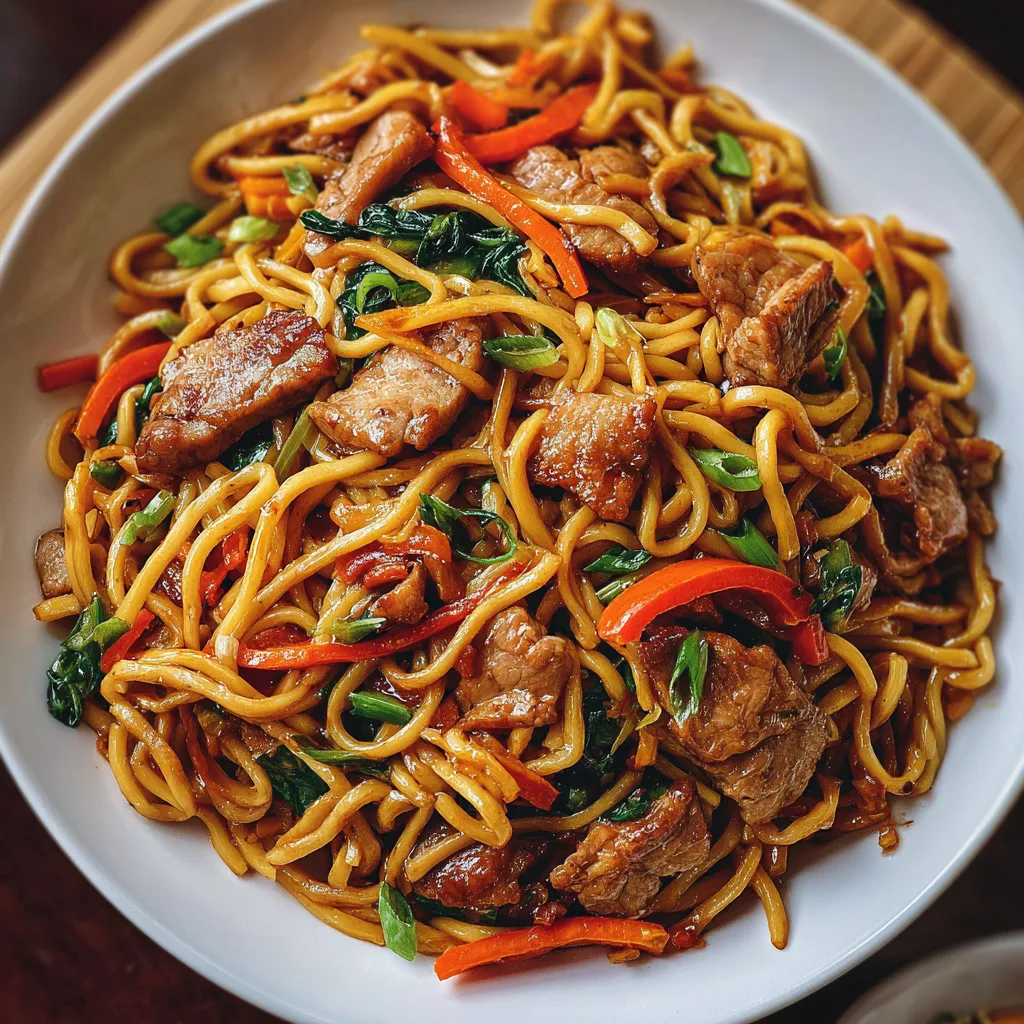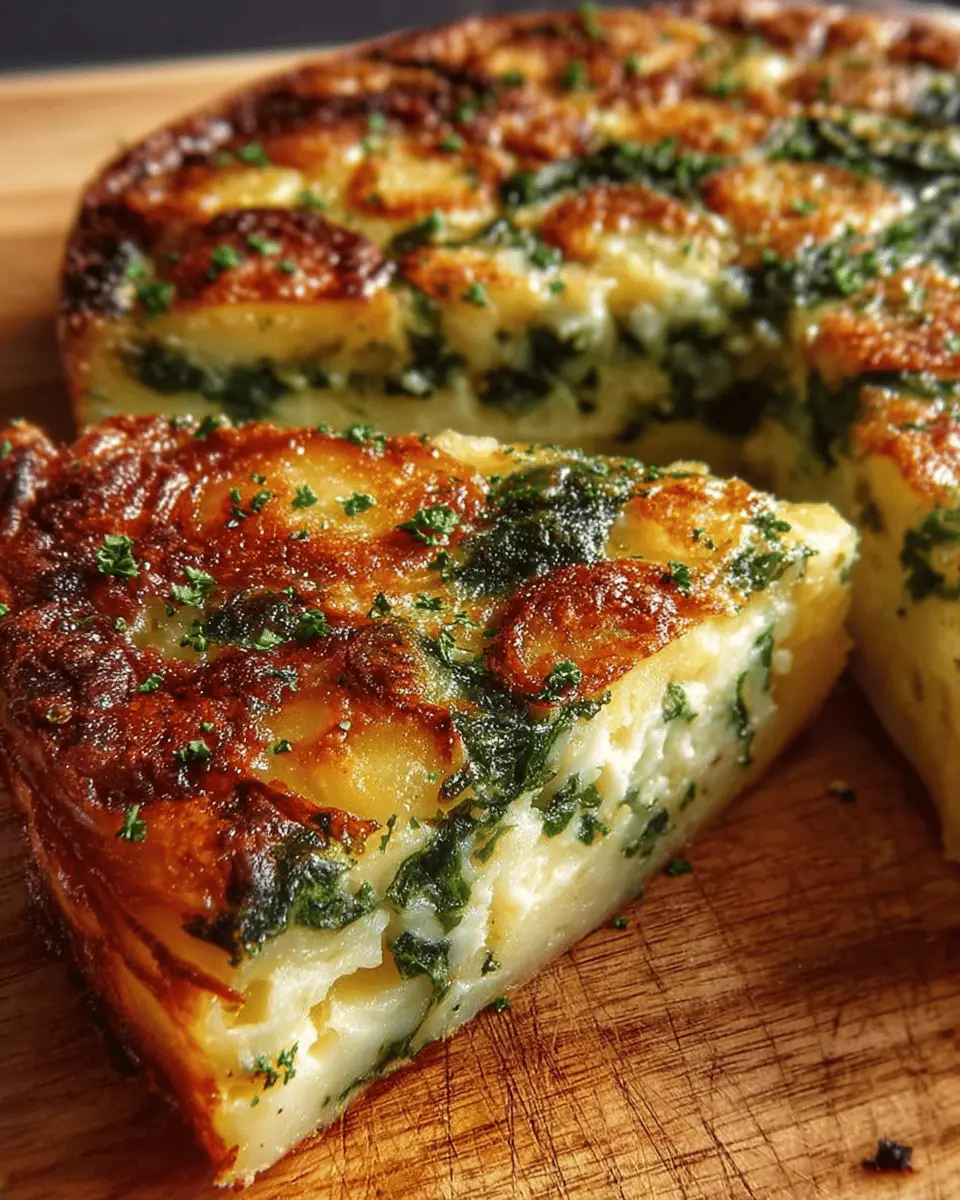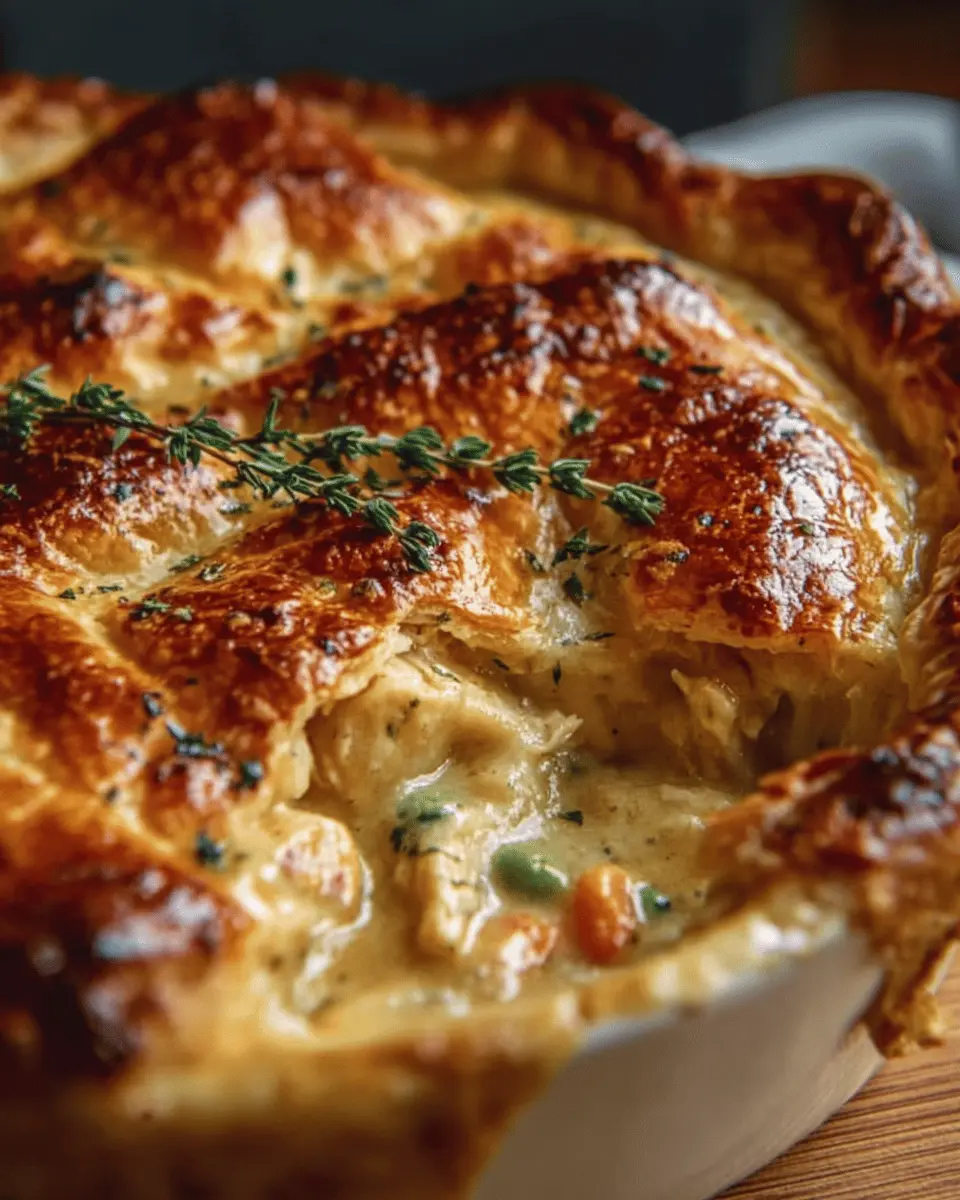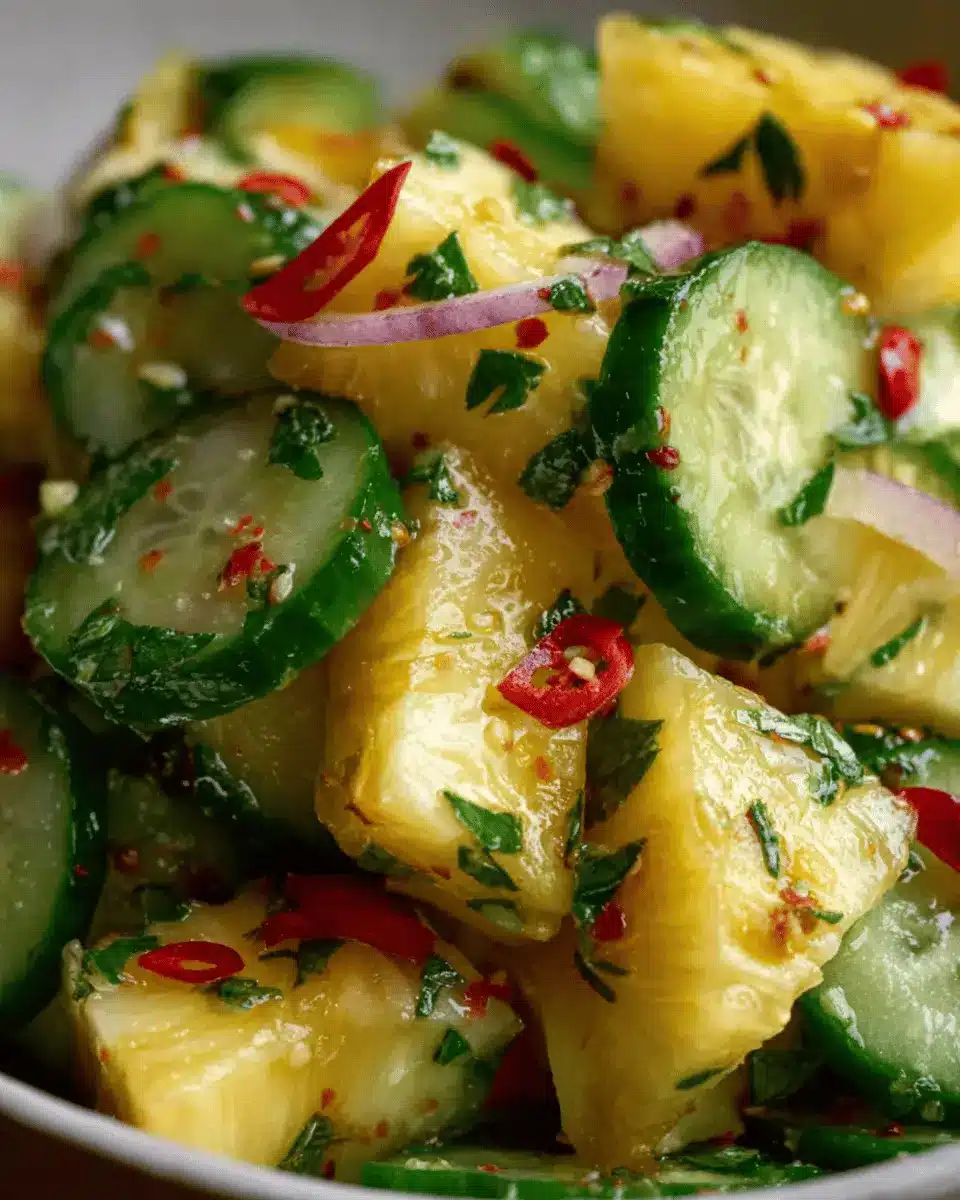Introduction
Pork Lo Mein is one of those dishes that brings instant comfort—chewy noodles, tender pork, and crisp vegetables all tossed in a savory, glossy sauce. It’s the kind of meal that hits every craving and somehow tastes even better than your favorite takeout. The good news? You can absolutely make it at home—and it’s easier than you think.
This recipe walks you through every step to create your own delicious, homemade Pork Lo Mein. It’s quick, flexible, and made with pantry staples you probably already have. Whether you’re cooking for your family on a weeknight or whipping up something satisfying just for yourself, this dish checks all the boxes. Let’s dive in.
Why You’ll Love This Pork Lo Mein Recipe
Key Benefits
This isn’t just another stir-fry—it’s your new favorite go-to. Here’s why:
-
Quick and easy: From start to finish, it’s on the table in under 30 minutes.
-
Better than takeout: Fresher ingredients, less oil, and full control over what goes into your dish.
-
Totally customizable: Use the veggies you love or the ones you’ve got left in the fridge.
Suitable For
-
Busy weeknights when time is short but hunger is high.
-
Beginner cooks looking for a foolproof first stir-fry.
-
Families who want a dish everyone can enjoy—and maybe even sneak in some extra veggies.
Ingredients for Pork Lo Mein
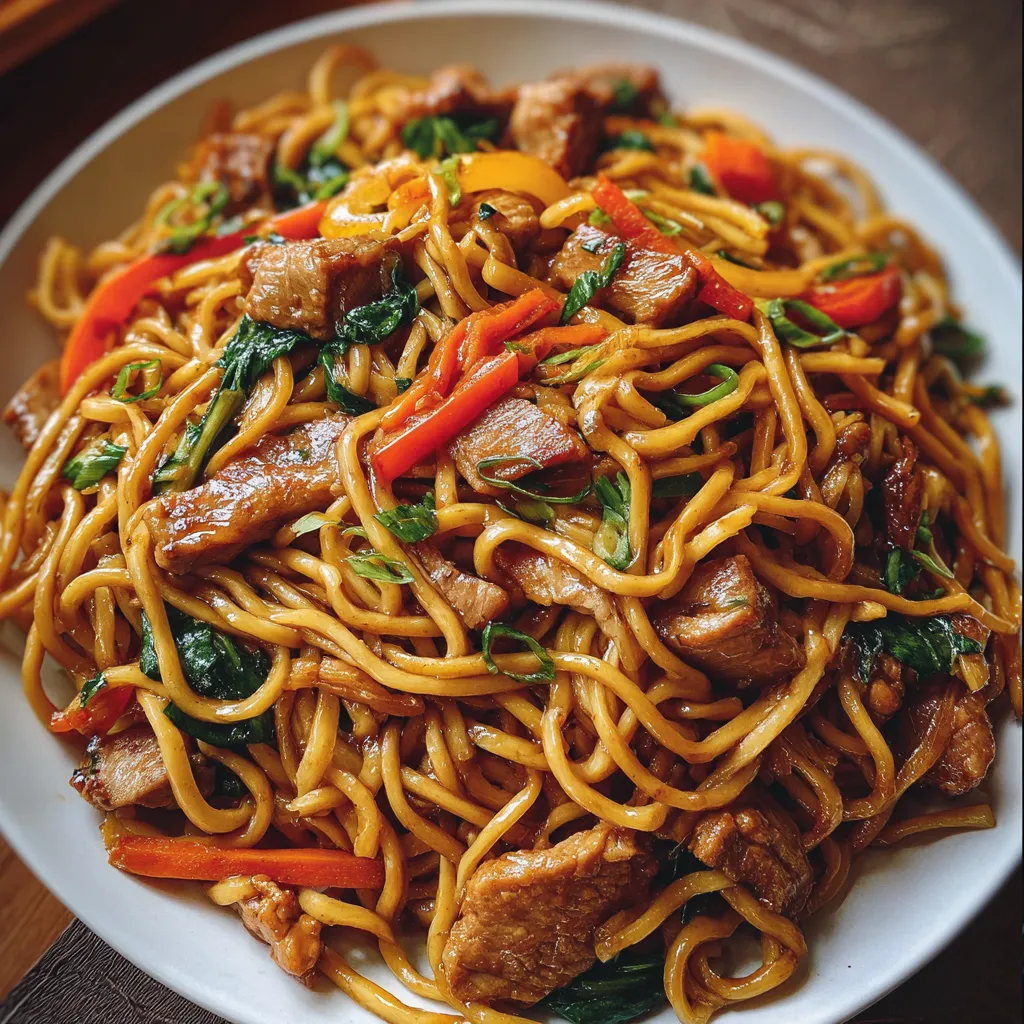
Core Ingredients
Here’s everything you’ll need for the most flavorful, satisfying Pork Lo Mein:
-
Pork: Thinly sliced pork tenderloin or boneless pork chops. Tender, quick-cooking, and perfect for stir-frying.
-
Lo Mein Noodles: Traditional Chinese lo mein noodles are ideal, but spaghetti or linguine work great in a pinch.
-
Sauce Base: A flavorful mix of soy sauce, oyster sauce, hoisin sauce, rice vinegar, sugar, and chicken broth.
-
Aromatics: Garlic and ginger bring the signature flavor punch.
-
Vegetables: Bell peppers, shredded cabbage or bok choy, carrots, and onions for that fresh crunch.
-
Seasoning Essentials: A little sesame oil adds a rich, nutty finish; cornstarch helps the pork brown beautifully.
Substitutions and Tips
This dish is incredibly forgiving. Use what you’ve got, and don’t be afraid to mix things up:
-
No pork? Chicken, shrimp, beef, or even tofu will do just fine.
-
No lo mein noodles? Try ramen, udon, or even rice noodles for a different texture.
-
Low-sodium needs? Use low-sodium soy sauce and unsalted broth.
-
More veggies? Toss in snap peas, mushrooms, bean sprouts, or baby corn—whatever you love or need to use up.
Pro tip: Prep everything in advance—this dish moves fast once the heat goes on.
Best Pork Cuts for Lo Mein
For the juiciest, most tender pork, pork tenderloin is your best bet. It cooks quickly and stays wonderfully moist. Boneless pork chops work too—just make sure to slice them thin.
A little trick to make slicing even easier? Pop the pork in the freezer for 15 to 20 minutes before cutting. This firms it up just enough to get those perfect, thin strips without any fuss.
Kitchen Tools You’ll Need
Must-Have Tools
You don’t need a restaurant kitchen to make Pork Lo Mein, but a few basics will make things smoother:
-
Wok or large skillet: You want space for tossing everything together without crowding.
-
Mixing bowls: For marinating the pork and mixing the sauce.
-
Tongs or chopsticks: Great for tossing noodles and veggies.
Nice-to-Have Tools
If you cook stir-fries often, these extras can make things even easier:
-
Garlic press or microplane: For fresh garlic and ginger without the chopping.
-
Spider strainer or colander: For draining noodles quickly.
-
Julienne peeler: Handy if you want picture-perfect veggie strips.
How to Make Pork Lo Mein
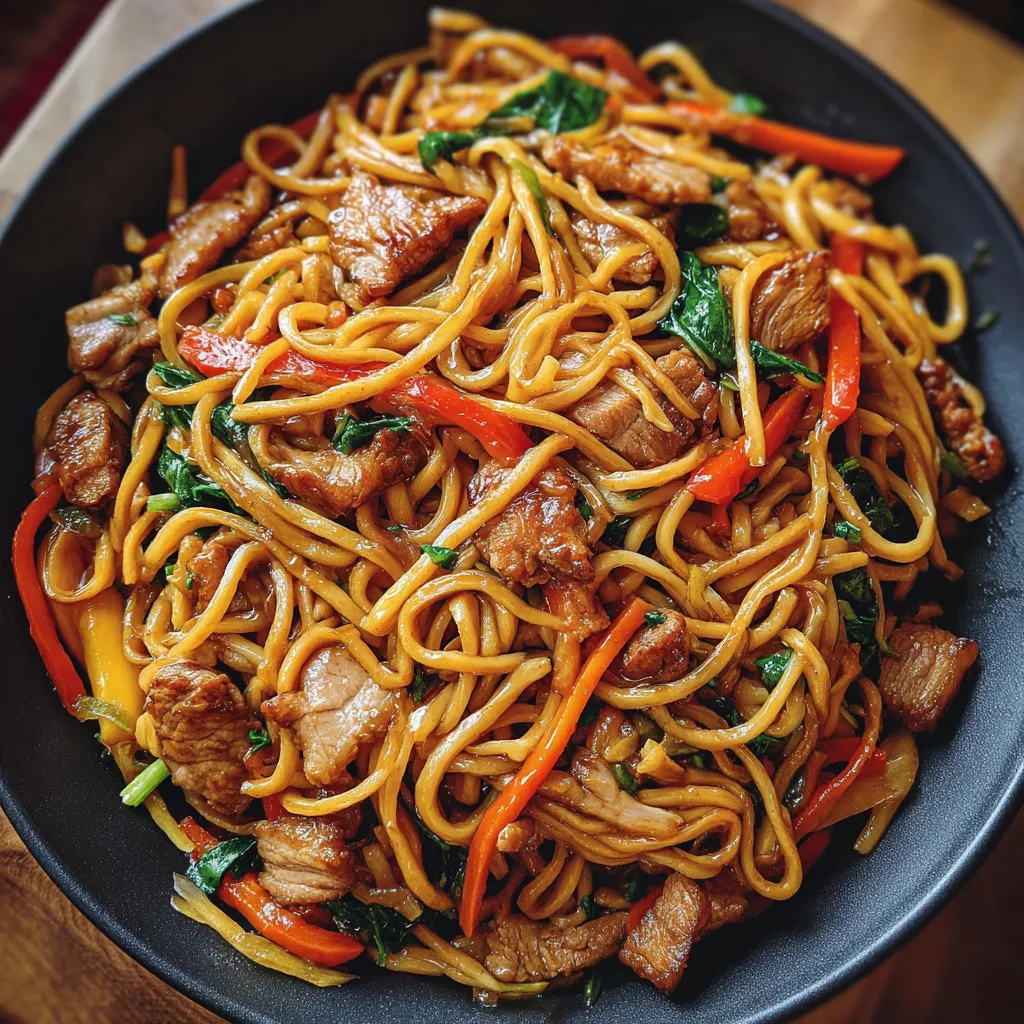
Ready to bring this comforting, flavor-packed dish to life? You’ve got everything prepped, your kitchen smells like ginger and garlic heaven, and now it’s time to put it all together. The cooking moves fast, so follow along step-by-step. Once you get the rhythm, you’ll be making Pork Lo Mein from memory in no time.
Step 1: Marinate the Pork
Start by giving the pork a quick marinade. In a bowl, combine the thinly sliced pork with soy sauce, cornstarch, and sesame oil. Toss it until everything is evenly coated.
This marinade isn’t just about flavor—it also helps the pork sear up beautifully and stay juicy during cooking. Let it sit while you prep your veggies. Even ten minutes makes a difference.
Tip: If you’re slicing the pork ahead of time, you can let it marinate in the fridge for up to an hour.
Step 2: Cook the Noodles
Boil your noodles according to the package instructions. You want them tender but still springy—al dente is ideal.
Once they’re done, drain them and rinse with cold water right away. This stops the cooking process and helps keep them from clumping together when you stir-fry later.
Shortcut: If you’re using spaghetti, cook it one minute less than the package says—your pan will finish the job.
Step 3: Mix the Sauce
In a small bowl or measuring cup, whisk together soy sauce, oyster sauce, hoisin sauce, rice vinegar, sugar, and chicken broth.
This simple combo creates a rich, balanced sauce with sweet, savory, and umami notes. The hoisin brings a little depth, the vinegar cuts through the richness, and the broth stretches it all so the noodles can soak it in.
Optional: For a deeper flavor and color, add a splash of dark soy sauce here.
Step 4: Cook the Pork
Heat a wok or large skillet over medium-high heat. Add a tablespoon of oil and swirl to coat the pan.
Once the oil is hot, add the marinated pork in a single layer. Let it sear undisturbed for a minute before stirring—this helps get that golden edge. Cook for 2 to 3 minutes, just until it’s no longer pink.
Remove the pork from the pan and set it aside. You’ll add it back in later.
Reminder: Don’t overcrowd the pan. If you’re doubling the recipe, cook the pork in batches.
Step 5: Stir-Fry the Vegetables
In the same pan, add another small drizzle of oil if needed. Add garlic and ginger first, and stir for about 30 seconds—just until fragrant.
Next, toss in the onions, bell peppers, cabbage (or bok choy), and carrots. Stir-fry for 3 to 4 minutes, or until they’re just tender but still crisp. You want bright color and a little crunch left.
Tip: Don’t walk away here. Stir-frying is fast—keep things moving in the pan.
Step 6: Combine Everything
Now for the magic. Add the noodles and cooked pork back into the pan with the vegetables. Pour the sauce over everything.
Toss gently but thoroughly, using tongs or chopsticks to coat the noodles in the sauce and mix all the ingredients. Let it cook together for 1 to 2 more minutes, just until everything is hot and the flavors meld.
Finish with: A sprinkle of sliced green onions for that fresh, sharp bite right at the end.
Tips for Success
-
Slice your pork thinly. Freezing it for 15 minutes before slicing makes it easier to get thin, even strips.
-
Use high heat. A good stir-fry needs heat to sear, not steam.
-
Prep everything before you cook. Once the heat’s on, there’s no time to chop or measure.
-
Don’t overdo the sauce. Start with most of it, then add the rest only if needed—this keeps your noodles from getting soggy.
-
Toss gently. Too much force can break the noodles.
This is one of those recipes where practice makes perfect—and luckily, it’s delicious every time.
How to Store Pork Lo Mein
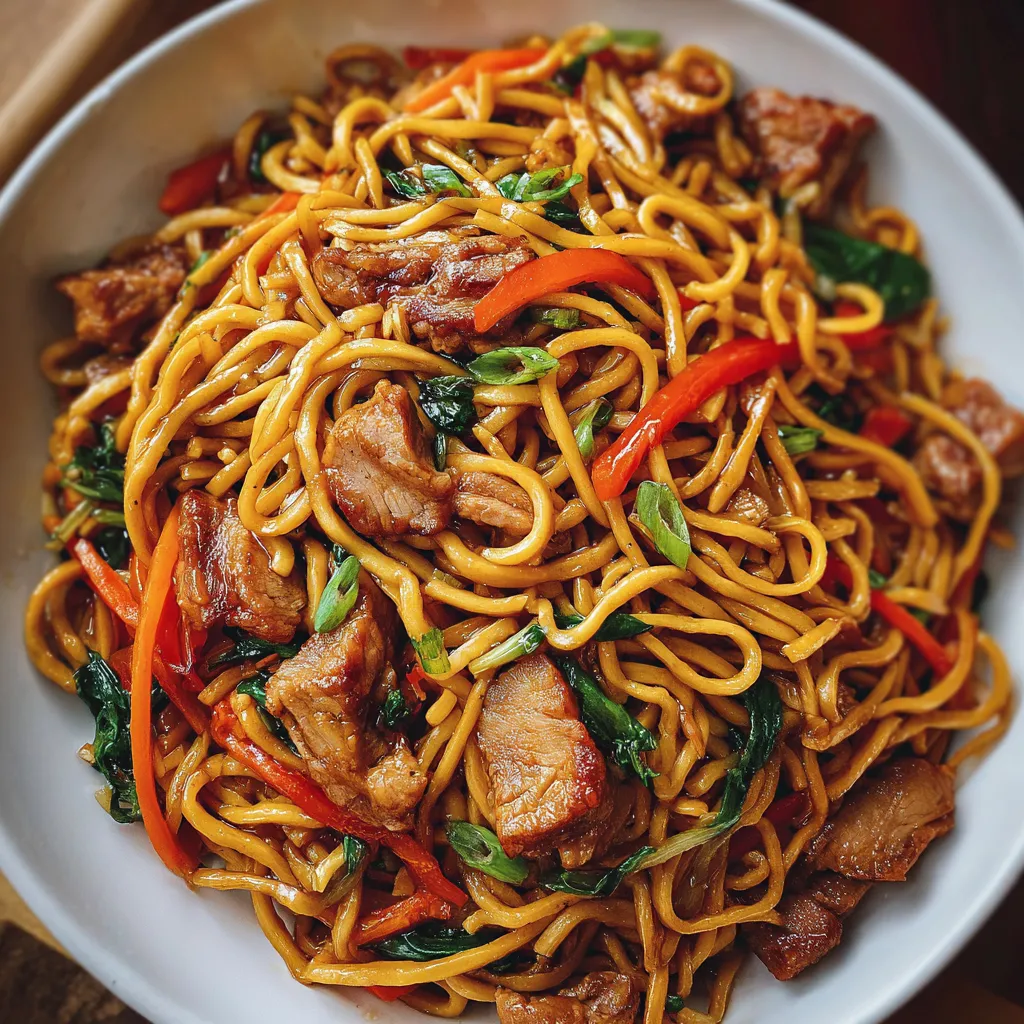
Leftovers? You’re in luck. Pork Lo Mein holds up well for lunch the next day or even as a cold noodle snack straight from the fridge.
At Room Temperature
Don’t leave the finished dish out for more than 2 hours. After that, it’s best to refrigerate for food safety.
In the Refrigerator
Store in an airtight container for up to 4 days. Reheat in a skillet or microwave until hot, adding a splash of broth or water to loosen up the sauce if needed.
Freezing Tips
You can freeze Pork Lo Mein, but the texture of the noodles may change slightly.
-
Freeze in single portions for easy reheating.
-
Thaw in the fridge overnight.
-
Reheat in a skillet with a bit of oil or broth until everything is warmed through.
Frequently Asked Questions (FAQs)
Can I use a different protein?
Absolutely. Chicken, shrimp, beef, or even tofu are all excellent options. Just adjust your cooking time accordingly—shrimp cooks very quickly, and tofu does best if pressed and pan-fried before adding.
What noodles are best for Lo Mein?
Traditional Chinese lo mein noodles are ideal—they’re chewy, eggy, and made for stir-frying. But don’t worry if you can’t find them. Spaghetti, linguine, or even ramen will work in a pinch.
Can I make this dish spicy?
Definitely. Stir in chili garlic sauce, Sriracha, or red pepper flakes with the sauce mixture. You can also finish with chili oil if you like that extra kick.
How do I prevent soggy noodles?
Cook your noodles al dente and rinse them in cold water after boiling. Then wait to add them to the stir-fry until the very end, so they don’t overcook or absorb too much sauce.
Related Recipes
If you loved this Pork Lo Mein recipe, you might also enjoy these savory dishes:
-
Sizzling Chinese Pepper Steak with Onions: A bold, beefy stir-fry packed with flavor.
-
Chinese Chicken Cabbage Stir-Fry: Light, crunchy, and quick to make.
-
Panda Express Style Chow Mein: A restaurant-style noodle favorite made at home.
-
15-Minute Mongolian Noodles with Ground Beef: A fast, saucy noodle dish with bold Asian flavors.
-
Chinese Beef and Onion Stir Fry: Tender beef cooked with onions in a sweet and savory glaze.
Conclusion
There’s something incredibly satisfying about mastering your own takeout-style Pork Lo Mein. It’s cozy, flavorful, and endlessly adaptable—and once you try it, you might just stop ordering in.
Print
Pork Lo Mein Recipe
- Total Time: 30 minutes
- Yield: 4 servings
- Diet: Low Lactose
Description
This Pork Lo Mein is a fast, flavorful stir-fry with juicy pork, crisp veggies, and chewy noodles tossed in a savory sauce. A delicious takeout classic made easy at home!
Ingredients
- 1 tablespoon soy sauce
- 1 teaspoon cornstarch
- 1 teaspoon sesame oil
- ¾ lb pork tenderloin or boneless pork chops, thinly sliced
- 8 oz lo mein noodles or spaghetti
- 1 tablespoon vegetable oil
- 2 cloves garlic, minced
- 1 teaspoon fresh ginger, grated
- 1 small onion, sliced
- 1 cup bell peppers, sliced
- 1 cup shredded cabbage or bok choy
- 1 cup carrots, julienned
- Green onions, sliced (for garnish)
- 3 tablespoons soy sauce (for sauce)
- 2 tablespoons oyster sauce
- 1 tablespoon hoisin sauce
- 1 tablespoon rice vinegar
- 1 teaspoon sugar
- ½ cup chicken broth
Instructions
- In a bowl, toss pork with soy sauce, cornstarch, and sesame oil. Let it marinate while prepping other ingredients.
- Cook noodles according to package directions. Drain and rinse under cold water. Set aside.
- In a small bowl, whisk together all sauce ingredients and set aside.
- Heat oil in a wok over medium-high heat. Stir-fry pork for 2–3 minutes until just cooked. Remove and set aside.
- In the same pan, stir-fry garlic, ginger, onion, bell peppers, cabbage, and carrots for 3–4 minutes.
- Add noodles, pork, and sauce to the pan. Toss well and cook 1–2 more minutes until everything is heated through.
- Garnish with green onions and serve hot.
Notes
- For a deeper flavor, add a splash of dark soy sauce.
- Freeze pork 15 minutes before slicing for easier cutting.
- Swap in mushrooms, snow peas, or bean sprouts for variety.
- Prep Time: 15 minutes
- Cook Time: 15 minutes
- Category: Main Dish
- Method: Stir-Fry
- Cuisine: Chinese
Nutrition
- Serving Size: 1 serving
- Calories: 420
- Sugar: 7g
- Sodium: 890mg
- Fat: 18g
- Saturated Fat: 4g
- Unsaturated Fat: 12g
- Trans Fat: 0g
- Carbohydrates: 42g
- Fiber: 4g
- Protein: 25g
- Cholesterol: 60mg

